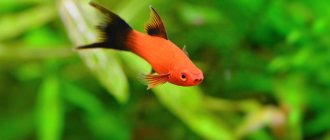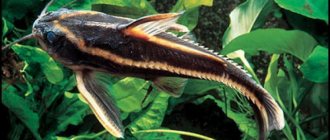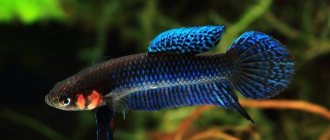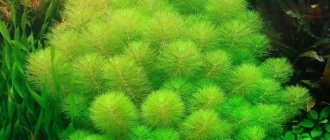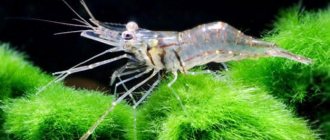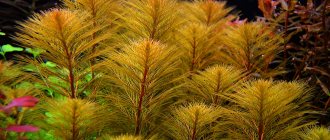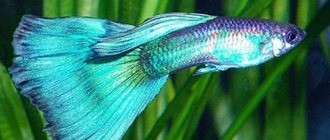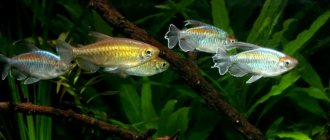Swordtails
Most species of swordtails that can be found on sale today are artificially bred. This is the price of the popularity of these fish, which are probably second only to guppies in demand. However, natural forms have also remained on the market. In order not to get confused in such diversity, you need to get to know each species better.
Alvarez's Swordbearer
Like all swordtails, it is part of the poeciliaceae family. The second name is blue swordtail. Natural appearance, not modified by breeders. Homeland - rivers of Guatemala and Mexico.
The color is silver with a blue tint, 2-3 stripes of red-brown and blue colors are noticeable on the sides, running from the head to the tail. The sword is usually yellow with a black edging, but there are fish with a green or red “sword”. The lateral and pectoral fins are colorless, the dorsal fins have red speckles.
Peace-loving fish, can be housed with others. In captivity it grows up to 4-5 cm, in the natural environment - from 6 cm (males) to 7.5 cm (females). Lives 2-3 years.
Since the native environment for the species is fast-flowing rivers, a water flow is also created in the aquarium, providing active aeration.
Conditions of detention:
- water temperature +24…+28 degrees;
- hardness from 10 to 20 dH;
- acidity 7-8.5 pH;
- aquarium volume – from 10 liters per fish.
Habitat
The homeland of swordtails is Central America. They are found in bodies of water in countries such as Mexico, Honduras and Guatemala.
It is noteworthy that their endurance and ability to adapt allows them to live in a wide variety of biotopes: in slowly flowing small rivers, in mountain rivers with strong currents, and even in wetlands and stagnant lakes. Moreover, today they have spread in nature and beyond their natural range. Swordtails are found in the waters of India, Africa, the USA and even the UK.
The species has become invasive in some regions, threatening natural biodiversity. And the reason for this is the person himself. Aquarists provoked this situation by releasing swordtails into natural conditions in their countries.
Round-headed swordtail
It is distinguished by a high rounded forehead and a large dorsal fin, similar to a fan. Males do not have a sword at all, or instead have a tiny appendage. The size of the fish is 5-7 cm.
Also a natural variety that came to us from tropical rivers. The color of the scales is silver with a pinkish tint, and there are transverse gray stripes along the body. The dorsal fin of females is gray with dark speckles, while that of males is bright yellow. The remaining fins and tail are colorless.
The requirements for maintenance and feeding are the same as for the Alvarez swordtail, the only peculiarity of the species is that there should be at least twice as many girls as boys.
How to choose?
All types of swordtails are peaceful and unpretentious in keeping, so when choosing a fish you should rely on your own preferences, as well as external signs.
The fish should not have:
- damage;
- inflammation;
- whitish coating or dots;
- sunken abdomen.
It is also worth paying attention to the regularity of breathing: too frequent swallowing indicates a lack of oxygen in the aquarium or parasites in the gills.
Breeding forms often suffer from deformations due to linear crossing. It is worth taking a closer look to see if the swordtail has a curvature of the spine or other developmental defects.
The behavior of the fish may also indicate the presence of any problems. The individual somersaults, drowns, rolls, stands on the bottom, itches, “vibrates”, swims at an angle - all this is not normal for the species, which means the fish is unhealthy.
Montezuma's Swordtail
The species is also called Royal. The males of this species are bright yellow fish measuring from 4 to 6 cm with a black and white sword so elongated that it is twice the length of the body. There are brown and silver-lilac color options.
The fins are transparent, yellowish, only the dorsal fins are of a rich color, fan-shaped, strewn with black spots. Girls look more prosaic: gray scales with a black stripe along the body.
Montezuma's swordtail is a rare and expensive species, the cost of an opposite-sex pair reaches up to $100. For this reason, the fish is not popular among amateur aquarists.
Content requirements:
- water temperature +22…+26 degrees;
- hardness from 5 to 15 dH;
- acidity not higher than 7-8 pH;
- numerous hiding places in the aquarium.
The fish is peaceful and gets along with other species. For successful reproduction of 4-6 females, 1 male is needed.
Pygmy swordtail
It is also called dwarf. In nature, the species lives in eastern Mexico. The smallest representative of the genus grows to only 3-4 cm , female and male individuals are almost the same in size, girls are only slightly larger.
The main color of the scales in males is yellowish, in females it is silver, a brown stripe runs along the body, which in males is paler or completely absent. The fins are transparent; boys have dark spots on the dorsal, forming a longitudinal line. There is no sword as such, only a process 2-4 mm long. The anal fins form gonopodium.
A pygmy needs a lot of space, so an aquarium for 5-6 fish should be at least 80 liters. Other conditions:
- water temperature +24…+27 degrees;
- hardness from 5 to 18 dH;
- acidity 7-8 pH;
Pygmies are sensitive to the purity of water and cannot tolerate rotting excrement and food particles.
Breeding and reproduction of swordtails
Since swordtails are viviparous fish, they do not spawn. The eggs mature in the abdomen of the female. The process of the appearance of fry is called ovoviviparity and the main task of the aquarist is to preserve the offspring, since fish lack parental instinct.
Maturity in swordtails occurs at 5-7 months. Sexual characteristics of fish are clearly expressed. Males are smaller in size, they have an elongated ray of the caudal fin - “sword”, and for fertilization of females there is a modified anal fin - gonopodium. It is along the gonopodium, like a gutter, that the male’s reproductive products enter the female’s reproductive tract, to make it easier for the male to stay near her; there is a small hook at the end of the gonopodium.
Preparation, spawning, conditions
Special conditions for fertilization and spawning are not required; the whole process can take place perfectly in a general aquarium. During fertilization, you can observe how the male performs a kind of “mating dance” around the female, moving back and forth.
The maturation of eggs in the abdomen of the female lasts about 30 - 40 days, depending to a large extent on the water temperature (the higher, the faster it ripens) and feeding. And if you plan to keep the offspring, then it is recommended to place the female ready for spawning in a separate container.
Water for the aquarium can be taken from a common aquarium. The spawning aquarium should contain a large number of small-leaved, lush plants that will serve as shelter for the fry.
A female ready for spawning exhibits the following signs: the abdomen becomes larger and takes on a square shape. A characteristic “birth” spot appears, dark in color at the anus.
pregnant female livebearer
not pregnant female livebearer
Pregnant and ready to spawn female swordtail
The number of fry is from 15 to 100, depending on the age and size of the female.
Interestingly, the ambient temperature affects whether there will be more males or females among the fry. At lower temperatures, more females are born, and at higher temperatures, more males are born.
At the end of spawning, it is better to immediately return the female to the general aquarium, otherwise she will begin to eat her offspring. The fact is that in nature, when the fry appear, they immediately move away from the female with the current, she does not see them. But in an aquarium, fry can be perceived as food.
An interesting fact is the ability, under certain circumstances, of female swordtails to turn into a male. At the same time, she also acquires the external characteristics of a male in the form of a sword tail, gonopodium, etc. This usually happens when there are no males. The offspring from a female and a “former” female consists mainly of females (about 90%).
Clemensia's Swordbearer
A rare natural species, it lives in the Papaloapan region of Mexico. It is almost never found in amateur aquariums, as it reproduces poorly in captivity.
The fish is small, 4-5 cm. The color is silver with a blue or pink tint and a beige tint on the back; two scarlet lines are clearly visible along the body. The sword is yellow with a black edge; in some representatives it reaches 3.5 cm in length. The girls are painted in the same colors, but paler. The fins of representatives of the species are colorless or yellowish.
Water parameters:
- temperature from +22 to +26 degrees;
- hardness from 3 to 10 dH;
- acidity 7.2-8 pH.
Berlin Swordtail
The species first came to the Soviet Union from Berlin, hence its name. It was bred artificially as a result of crossing the black-tailed platy with the green swordtail.
The fish is painted in a bright red-orange color (one of the shades may dominate). The fins are dark, the “sword” is black. Boys and girls differ in body shape - in the former it is elongated and graceful, in the latter it is wide and round. The size of the Prussian swordtail is from 5 to 6 cm.
Water requirements:
- temperature from +16 to +27 degrees;
- hardness from 5 to 25 dH;
- acidity from 6.5 to 8.5 pH.
The Berlin swordtail crosses with other poeciliids, so if the owner wants to maintain the purity of the species, the fish should not be kept in the same aquarium with relatives.
There is also the Berlin Lyretail Swordtail. It is distinguished by elongated, elongated fins and tail; the male does not have a sword.
Cuban Swordtail
As the name implies, the species was brought from Cuba. Hybrid of platia tuxedo and green swordtail. In some countries, a “Cuban” is called Tuxedo (translated as “tuxedo”).
The color is varied - shades of orange, red, yellow, but there is always a distinctive feature in the form of a black spot, which is located near the tail and/or extends to the sides of the fish.
The size of the pet is modest, 4-5 cm. The sword of males comes in different lengths, its color matches the overall color of the body, as do the fins.
Conditions for keeping the species:
- water temperature +16…+27 degrees;
- hardness from 10 to 25 dH;
- acidity from 7 to 8.5 pH;
- It is necessary to maintain stable water parameters.
The Cuban swordtail needs to be provided with moderate water movement in the aquarium and algae cover.
Feeding
Fish are unpretentious in food, so any food will do (dry - flakes, granules, sticks, etc.), frozen and live food (brine shrimp, tubifex, aulophorus, daphnia, coretra, bloodworms, etc.). These aquarium inhabitants most often eat food near the surface, but can take food in all layers of water.
The best option is a balanced diet of plant and animal feed. Surprisingly, swordtails tolerate fasting well for 1-2 weeks, without harm to their health, provided that there is enough dense vegetation in the aquarium. The fish will eat the plants and algae that form on the walls of the aquarium.
Bulgarian white swordtail
Appeared as a result of crossing other varieties. The albino fish has a white color with an orange “cap” and red eyes. The fins and short sword are colorless.
It grows up to 7-9 cm, a strong and unpretentious pet. You need to feed a variety of foods, including live, plant-based, dry and frozen foods.
It reproduces well and mates with other species of swordtails.
Aquarium requirements:
- volume from 40 l for 4-5 fish;
- water temperature +23…+25 degrees (minimum +18);
- hardness 7-20 dH;
- acidity from 7 to 7.5 pH;
- good lighting.
Non-aggressive, suitable for group keeping.
Diseases
The most common diseases are viral and fungal; infection mainly comes from the external environment.
If you follow the care recommendations, your fish will be in good health.
To avoid the spread of diseases, it is advisable to keep new fish in quarantine before adding them to other fish:
- Place beginners in salt water for half an hour (1 tsp per 10 liters of water). This will help remove parasites from the surface of the fish and kill pathogens.
- Keep the fish under normal conditions, but in a separate aquarium for 7-14 days. If the fish is sick with something, it will become visible within two weeks. If the condition of the newcomers has not worsened, they can be released into the main aquarium.
It is easy to determine visually that a fish is sick - its fins may droop or stick together, small wounds or sores may appear, or a rash or plaque may appear.
Sometimes the virus can be introduced into an aquarium through low-quality food. Therefore, you can only buy it from reliable sellers and be sure to rinse it thoroughly before adding it to the aquarium.
Individuals with symptoms of the disease should be immediately separated so as not to infect others. The method of treatment will depend on what kind of disease has affected the fish.
[ads2]
Dropsy
There are many reasons for the occurrence of the disease - sudden changes in temperature, parasites, infection, high concentrations of nitrates or nitrites, poor quality nutrition. From sick individuals, the disease easily spreads to the rest of the inhabitants of the aquarium.
Fish with dropsy are usually lethargic, slow, and have rapid breathing. The abdominal cavity is swollen, the scales rise in an unnatural way. Fish can lie down on the bottom.
The infection is dangerous for people; it is necessary to wear a mask and gloves when working with sick fish.
To cure swordtails, you need to add a little Epsom salt to the aquarium (1 tsp per 20 liters of water). Bicilin, potassium permanganate, chlorafeminicol, maracin will also help.
Poisoning
If you add water to the aquarium that has not had time to settle, swordtails can be poisoned by chlorine.
This is evidenced by sluggish behavior, yellowing of the gills and the appearance of mucus on them. At the first symptoms, you need to transplant the fish into clean water.
Wounds
Sometimes males, competing for territory, can injure each other.
Fish can also be injured by touching sharp edges of decorations or equipment. To make the wounds heal faster and prevent a white coating from appearing on them, you need to add a little iodinol or hydrogen peroxide to the water (up to 20 ml per 40 liters of water).
Fin rot
Swordtails are especially susceptible to this disease. The disease affects young and weakened adults. The fins of affected fish are destroyed and become cloudy.
In the early stages, fish can be cured of rot, but if you do not react in time, the nervous system will suffer and the fish will die.
For treatment, you need to prepare a separate tank and fill it with a solution of water and methylene blue. The optimal concentration is a light turquoise solution. The fish should be sent into it until the symptoms disappear completely.
If there is nowhere to put the sick, you can add a little salt to the aquarium (1 tablespoon per 10 liters of water). This concentration will help kill the infection and will not harm healthy individuals.
Chilodenellosis
Swordtails are more vulnerable to this disease than other species. Symptoms include decreased appetite and mobility, drooping fins, and the appearance of a grayish coating under the dorsal fin.
Antiprotozoal drugs are used for treatment. It is important to diagnose the disease as early as possible and begin treatment. The more time has passed since infection, the less likely it is that the fish can be saved.
Fungus
White plaque indicates a fungal disease. It appears due to improper care, for example, if the aquarium is rarely cleaned, food residues or waste products accumulate. Salt baths (1 teaspoon of salt per liter of water) will help get rid of the fungus.
Mycobacteriosis
Affected individuals lose interest in food and become inactive. At advanced stages, it becomes difficult for them to swim; some individuals may lie on the bottom.
If the disease is detected in time, trypoflavin, copper sulfate or monocycline will help get rid of it.
Red swordtail
He is also the sword-bearer Comet. Another hybrid, completely red (including fins and sword), with a barely noticeable dark stripe running along the body. There are fish of an orange hue, the females are paler than the males. Size – up to 10 cm.
The red swordtail has several subspecies.
There are decorative forms of these swordtails:
- forked (with elongated fin edges and three rays on the tail);
- sailing (with a large, fluttering dorsal fin);
- veil (with elongated, luxurious fins and tail);
- lyretail (with rays of the same size along the edges of the tail);
- flag (with a large, wide fin on the back).
Ruby swordtail, or Ruby
A variety of red. The color of Ruby's scales and fins is rich scarlet and monochromatic. There is a standard and fork shape. In the West, the ruby swordtail is also called the Vampire because the fish has red eyes.
Red dragon, or dragon
It is distinguished by the dark, almost black color of its fins and tail, and its body is red. The dorsal fin is triangular in shape, with a ray on the upper edge, there is also a ray on the anal fin, but there is no sword. The tail of a red dragon has two rays at the top and bottom, and there is also a third short ray in the middle.
The conditions for keeping all red swordtails are standard:
- water temperature +17…+27 degrees;
- hardness from 10 to 28 dH;
- acidity 7-8 pH.
They prefer live, including frozen food, but are generally unpretentious.
Heller's green swordtail
A natural species, the progenitor of numerous decorative hybrids, discovered in 1848 by the scientist Karl Heller.
Males reach 8 cm in length, females - 12 cm, the color does not differ much: both boys and girls have a gray color with an olive tint and a clear red line along the body. Several more lines, paler, may run parallel to it. The fins are colorless. Males are distinguished by a yellowish or greenish sword with a dark edging.
The conditions of detention are the same as for the sword bearer Clemencia.
Lemon swordtail
This is essentially an albino green swordtail. Color varies from yellow-green to bright lemon. It does not reproduce well in an aquarium; the species is not resistant to diseases and changes in living conditions.
Description
Swordtails belong to the family of viviparous toothed carps. The body is elongated, flattened laterally.
The natural background color of males is light brownish-olive, with a green tint on the back. A two-millimeter red stripe runs along the sides, and below and above it there are two more narrow red stripes. The long lower ray of the caudal fin (sword) has a clear black edge. The color of the female is much paler, the body has a silvery sheen, the middle of the body is occupied by a wide stripe, and below and above this stripe there are two more narrow stripes 0.5 mm wide.
As a result of selection, swordtails have not only a variety of fin shapes, but also different body colors: black, red, olive, orange, yellow and combinations thereof (for example, a yellow body and black fins). Swordtails have also been bred with two swords - at the bottom and the top of the tail.
The male's body (without the sword) can grow up to 8 cm, and the female's body up to 12 cm.
Swordtails live up to three to five years.
Black swordtail
An artificially bred species, it is distinguished by a uniform dark color and colorless fins. Males have a short sword of a pale yellow or greenish hue.
The size of the fish is from 7 to 10 cm, they are peaceful and unpretentious, but they need a spacious aquarium and do not tolerate overcrowding.
Water requirements:
- temperature +16…+27 degrees;
- hardness from 10 to 30 dH;
- acidity 7-8 pH.
Normally tolerates a short drop in temperature to +14...+15 degrees. Does not require shelters.
Compatibility
Swordtails are not aggressive, peaceful fish. They are compatible with all similar fish: tetras, neons, minors, thornets, zebrafish, all poeciliids: guppies (can bite), mollies, etc. They are compatible with almost all aquarium catfish - corydoratus (speckled catfish), acanthophthalmus, platidorus, ancistrus, sacbranch catfish, etc. Moreover, swordtails get along very well with peaceful and small cichlids, for example, with angelfish. It is not recommended to attach them to “veil” fish - they are slow and swordtails can “pinch” them by their beautiful, large fins. Not compatible with aggressive and large fish, for example, cichlids: acara, astronotus, diamond cichlids, etc.
Tiger swordtail, or red-speckled swordtail
The species was bred by crossing spotted and tricolor platies with Heller's swordtail.
The tiger pet is, of course, distinguished by its coloring: black spots are scattered throughout the monochromatic red body. The lateral, pectoral and anal fins are reddish, while the dorsal fin and tail are partly black. The sword of males is two-colored. The size of the fish is average, 7-8 cm.
This species has a lyretail form.
There are fish with a completely black tail and sword, but they are not used for breeding in order to preserve the breed.
Water parameters:
- temperature +23…+26 degrees;
- hardness from 6 to 20 dH;
- acidity no more than 7-7.5 pH.
Rainbow swordtail
Another hybrid of interesting colors: bright red, brownish or red-orange stripes stand out on silver-green scales. The fins, tail and sword can be colored red or orange in whole or in part.
The fish is quite large, from 7 cm to 9 cm, and is non-aggressive.
The water parameters for keeping are the same as for the Bulgarian white swordtail.
Calico swordtail
It differs from all varieties in its unique three-color color: the body is white with red or orange and black spots, the sword is dark and short. There are fish in which black color predominates or completely colors the tail.
It grows up to 8-10 cm, the size of the female is larger than the male.
Similar to Sanke's calico swordtail. Although the dark spots on its body are smaller, the two breeds are often confused.
The calico swordtail is difficult to breed because its colors are unstable. Among dozens of fry, only a few will have the correct color, and breeders cannot do anything about it yet.
Conditions of detention:
- water temperature +17…+28 degrees;
- hardness from 10 to 30 dH;
- moderate acidity, 7-8 pH;
Pineapple swordtail
Large species, 8-10 cm long. The main color is yellow, golden with a red stripe along the body. The abdomen, back and fins are painted in the same bright color. The sword is short, sometimes red or yellow, but always with a black edge.
The pineapple swordtail needs space: for 1 pair you need 40 liters of water, which should always be fresh.
Other options:
- water temperature +20…+26 degrees;
- hardness from 10 to 25 dH;
- acidity 7-8 pH.
Mountain swordtail
A fish with yellowish or cream-colored scales that shimmer with lilac and violet. There are black dots on the sides and dorsal fin; the fin itself, like the rest, is transparent, pale yellow.
Males differ from females not only in the presence of a sword, but also in the fact that their anal fin is narrow, needle-like, while their females have a fan-shaped one. The dorsal fin is also fan-shaped, regardless of gender.
The same water parameters are suitable for keeping as for the pineapple swordtail.
Hell's Swordsman
Another decorative look. Traditionally the color is black and white, but there are fish with red spots.
The body is silvery-white, shimmering in different shades, the fins are rich black, like the sword, the length of which reaches the size of the fish itself - from 8 to 10 cm.
This species has a lyretail form.
Any fish of a similar “weight category” will be suitable as a neighbor for a black-tailed pet.
Water with the same parameters as for Geller's swordtail is suitable for keeping.
Average prices in pet stores in Moscow
Swordtails can be purchased in pet stores in a variety of colors and fin shapes. The most popular remains the red swordtail. This is a classic of the aquarium genre. For such a fish, sellers of branded pet stores ask from 50 to 100 rubles. This is the price of a swordtail that has already grown up.
In simpler trade enterprises or from private individuals, the price of swordtails starts at 10 rubles. It is possible to receive swordtails as a gift. These fish reproduce quickly and fill the aquarium spaces. A caring owner periodically faces the task of transferring excessively proliferating swordtails to other hands.
Swordtail Koi
The fish are so named for their external resemblance to the Japanese carp of the same name. In fact, this group includes three species of swordtails: Kohaku, calico and Sanke. The first one is called Santa Claus due to its red and white coloring.
Santaclaus swordtail, also known as Kohaku, is a swordtail.
Kohaku has red or orange colors around the head and tail, the middle of the body is white, and the fins and sword are colorless. Calico and Sanke have black spots.
Similar to the Calico, the Sanke differs in the form of larger black markings.
In an aquarium, the Kohaku species grows up to 10 cm. The maintenance requirements for all three breeds are the same (see the section on the calico swordtail).
As you can see, most species of swordtails are unpretentious and easy-going, so they can be safely recommended to both professionals and aquarium hobbyists. If you monitor the cleanliness of the aquarium, aeration and quality of food, the fish will live up to 3-5 years.
Conditions of detention
Swordtails belong to the so-called “harem” fish. It is optimal to keep 2-3 females per 1 male in one aquarium. If you decide to keep several males, then you need to arrange shelters in the aquarium where weaker males can hide from the attacks of their relatives. Under optimal conditions, life expectancy reaches up to 5 years.
Aquarium
For a group of swordtails of 3-4 individuals, of which one is a male and the rest are females, you will need an aquarium of 50 liters or more. Fish are characterized by mobility and jumping ability, so it is necessary to provide the aquarium with a lid.
About water
It is recommended to take care of high-quality water filtration and good oxygen saturation. The optimal temperature for keeping swordtails is 20-28°C, water hardness is in the range of 9-19° dGH and pH = 7.0-8.0, but these fish do not really like frequent water changes in the aquarium, 25-30% of the aquarium volume It is recommended to replace it once every one to two weeks. You need to take into account the majority of the population of the aquarium, because for most tropical fish, replacing once a week is usually the norm, but swordtails do not like this.
Some aquarists periodically, both for medicinal purposes and for prevention, add a little salt to the water - a concentration of up to 1 g/l. Provided that there are no other fish species living with the swordtails that could be harmed by salt.
What is the best soil to choose?
The choice is not important - any will do. But swordtails will look more impressive against the background of dark soil.
Vegetation and scenery
Since in nature these fish thrive in dense thickets, similar conditions for their comfort should be created in the aquarium. Use plants: cryptocoryne, vallisneria, echinodorus, etc., the more magnificent, the better.
But thickets should be alternated with space for free swimming. It is also recommended to place natural driftwood at the bottom; they will become an excellent place for the growth of microalgae, the fouling of which swordtails love to feast on.
Other decorations in the form of pots, grottoes, castles, etc., which the fish will use for relaxation, are also welcome.
Equipment
The aquarium should be equipped according to the standard, as for most other types of fish, these are filters (external or internal, depending on the volume of the aquarium), an aerator, a thermostat, a thermometer.
Lighting
Swordtails are not demanding of lighting; diffused lighting is best. It all depends on the population of the aquarium, if there are a lot of plants in it, then the range and intensity should be appropriate.
